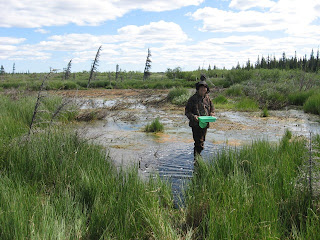
Dear Society,
Amanda here! Today was a day full of mud and bugs. We visited two wetlands in the morning and three in the afternoon. It’s exactly 5:00pm at the moment and I’m a little past exhausted. Most of the wetlands today were spaced pretty far apart so we got a pretty awesome workout walking through mud and goop in between each one. We collected things like tadpoles, dragon fly larva, and diving beetles. We saw Boreal Chorus frogs, Wood frogs, a Golden eagle, damselflies, stickleback fish, and a few fairy shrimp. It was a beautiful day, but warmer than yesterday, therefore more mosquitoes and bull dog flies. Even though we saw/gathered many little creatures, it was quite an effort to find them. Sometimes we’d spend a whole 30 minutes at one wetland searching for significant bugs, but only walk away with one lonely diving beetle, which was kind of depressing. Dinner is at 5:30 every day, which for most people that’s pretty early, but right now I would consider myself on the edge of starving. Did I mention the food here is amazing? Because it is. They have a very vegetarian friendly menu, which is always nice. When we get back from our “afternoon wetland trips” each team records/organizes their own data they collected. This consists of things like labelling and dividing up all the creatures we kept into vials filled with ethanol, filtering water samples and organizing them into capsules, and recording measurements of wetlands and their characteristics onto a spreadsheet. I didn’t realize how much technical equipment I’d get to use/learn about on a daily basis. At first it’s super confusing and really scary, but by the end of the day I actually understand what I’m doing and can do some of the tasks all by myself. It’s quite a self-improvement that I’m very proud. Later this evening we have a lecture on polar bears, which I am very excited about. Well, dinner is being served so gotta go!


Amanda


